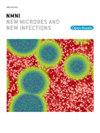登革热患者血小板动态和血小板减少:来自中国深圳的一项前瞻性队列研究
IF 5.4
Q2 INFECTIOUS DISEASES
引用次数: 0
摘要
登革热是最流行的节肢动物传播的病毒性疾病,每年导致约4亿人感染。虽然血小板减少症通常与登革热有关,但它如何演变与病毒载量和免疫反应的关系仍然知之甚少。本研究旨在通过系统跟踪病毒载量、血小板参数和白细胞动力学来阐明急性登革热中血小板-病毒-免疫相互作用。方法采用2014 - 2023年的回顾性数据,于2024年在第三人民医院开展前瞻性队列研究,纳入135例登革热确诊病例。纵向追踪血小板计数、红细胞压积(HCT)和细胞免疫标记物(淋巴细胞/中性粒细胞百分比)。通过NS5基因Ct值定量病毒载量。统计分析采用黄土回归和Pearson/Spearman相关。结果血小板计数呈双相下降,在发病后第6天降至最低点(平均97.65 × 109/L),第9天恢复。血小板减少严重程度分为中低(50 - 99 × 109/L; 50%, 64/128)和极低(50 × 109/L; 14.8%, 19/128)。血小板下降与淋巴细胞百分比升高(40% vs.下降前的17.8%;p < 0.001)和中性粒细胞抑制(46.6% vs. 68.3%; p < 0.001)相关。关键的是,血小板计数与病毒载量(Ct值:R = 0.25, p = 0.028)、HCT (R = - 0.25)和血小板激活标志物(MPV: R = - 0.55; p - lcr: R = - 0.57)呈负相关,而与血小板血细胞比容(PCT: R = 0.97)呈正相关。尽管有严重的血小板减少症,但没有病例进展为严重的登革热。结论:本研究确定了由病毒载量驱动的登革热血小板减少动力学。主要的中度血小板减少症(50-99 × 109/L)挑战了传统的风险分层,提倡综合监测血小板指数和病毒复制。这些数据促进了血小板-病毒相互作用的风险预测和机制知识。本文章由计算机程序翻译,如有差异,请以英文原文为准。
Platelet dynamics and thrombocytopenia in dengue fever: A prospective cohort study from Shenzhen, China
Introduction
Dengue fever, the most prevalent arthropod-borne viral disease, causes ∼400 million infections annually. Although thrombocytopenia is commonly associated with dengue, how it evolves in relation to viral load and immune responses remains poorly understood. This study aimed to elucidate platelet-virus-immune interactions in acute dengue by systematically tracking of viral load, platelet parameters, and leukocyte dynamics.
Methods
A prospective cohort study was conducted at Third People's Hospital in 2024, involving 135 confirmed dengue cases, supported by retrospective data from 2014 to 2023. Platelet counts, hematocrit (HCT), and cellular immunity markers (lymphocyte/neutrophil percentages) were longitudinally tracked. Viral load was quantified via NS5 gene Ct values. Statistical analyses involved LOESS regression and Pearson/Spearman correlations.
Results
Platelet counts exhibited a biphasic decline, reaching nadir levels (mean: 97.65 × 109/L) at 6 days post-onset, with recovery by day 9. Thrombocytopenia severity was stratified as intermediate-low (50–99 × 109/L; 50 %, 64/128) and very low (<50 × 109/L; 14.8 %, 19/128). Platelet decline correlated with elevated lymphocyte percentages (40 % vs. 17.8 % pre-decline; p < 0.001) and suppressed neutrophils (46.6 % vs. 68.3 %; p < 0.001). Critically, platelet counts inversely correlated with viral load (Ct values: R = 0.25, p = 0.028), HCT (R = −0.25), and platelet activation markers (MPV: R = −0.55; P-LCR: R = −0.57), while positively associating with platelet hematocrit (PCT: R = 0.97). No cases progressed to severe dengue despite extreme thrombocytopenia.
Conclusions
This study identifies distinct dengue thrombocytopenia kinetics driven by viral load. Predominant moderate thrombocytopenia (50–99 × 109/L) challenges conventional risk stratification, advocating integrated monitoring of platelet indices and viral replication. These data advance both risk prediction and mechanistic knowledge of platelet-virus interactions.
求助全文
通过发布文献求助,成功后即可免费获取论文全文。
去求助
来源期刊

New Microbes and New Infections
Medicine-Infectious Diseases
CiteScore
10.00
自引率
2.50%
发文量
91
审稿时长
114 days
 求助内容:
求助内容: 应助结果提醒方式:
应助结果提醒方式:


